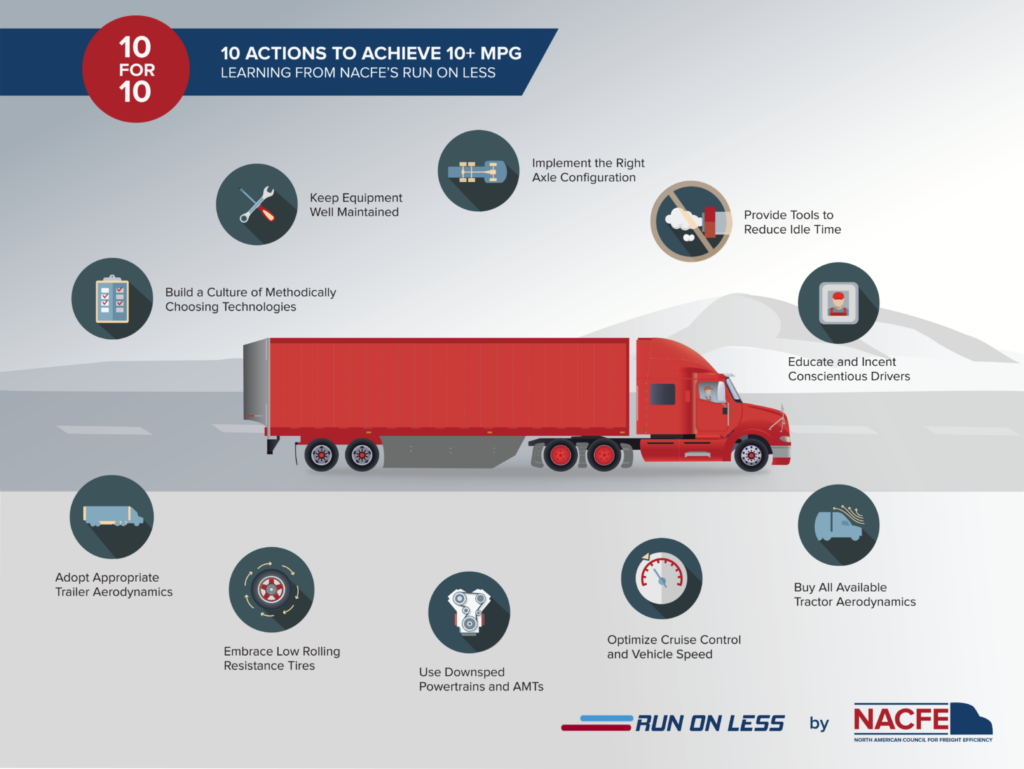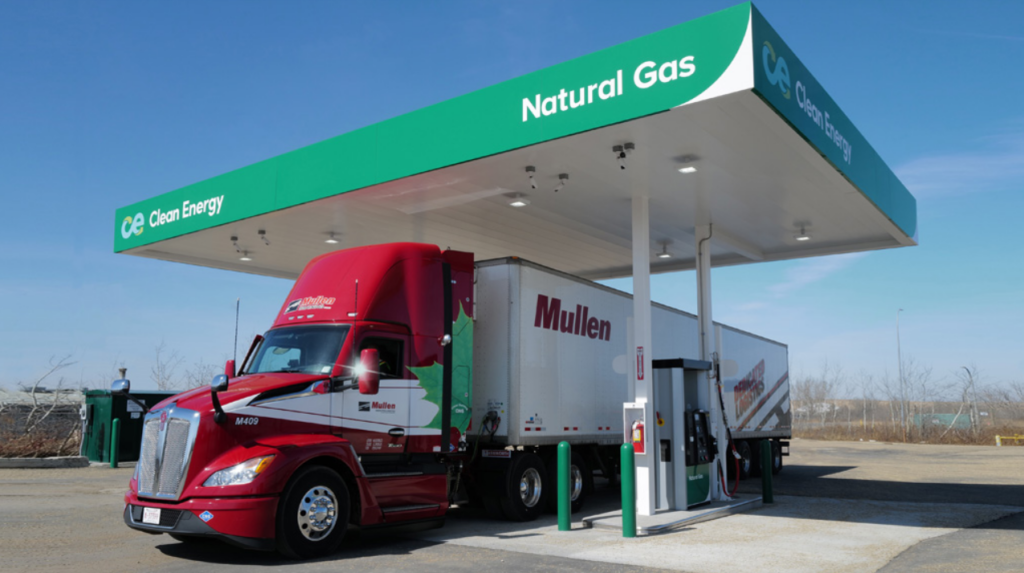Decarbonizing trucking begins with today’s diesel and natural gas engines
Mike Roeth doesn’t want to hear that the trucking industry will need to transition en masse and immediately to electric and hydrogen-fueled powertrains if the industry wants to decarbonize.
“That’s complete bullshit,” the normally mild-mannered head of the North American Council for Freight Efficiency (NACFE) declared when presented with that popular narrative. “I’m very frustrated that it seems many feel decbarbonizing, or improving our carbon footprint, can only be done with EVs and hydrogen. We need to be preaching that burning less fuel while moving the same amount of freight is decarbonizing, helping our planet, reducing costs and emissions. A gallon of fuel not burned is so important and I think it’s incumbent upon all of us to keep working on improving diesel trucks and to tell that story.”

Indeed, there’s a positive story to tell regarding improvements to the environmental performance of diesel engine technologies. The Engine Technology Forum, previously known as the Diesel Technology Forum, announced recently that 57% of commercial diesel trucks on U.S. roads are now “near-zero” emissions models (EPA10 technologies).
Of Class 8 trucks, 96.8% continue to be powered by diesel, the forum noted, while only 0.2% are electric. Looking more broadly at the Classes 3-8 market, 75.6% are diesel-powered and just 0.09% electric. The population of Class 8 trucks with EPA10 diesel technologies surged 10.2% from 2021 to 2022.
These trucks are equipped with diesel particulate filters (DPFs) to trap and eliminate particulate matter, and selective catalytic reduction (SCR) systems to remove harmful NOx emissions.
“Nearly 7 million new-technology diesel trucks are on the roads, delivering our goods and services with near-zero emissions,” Allen Schaeffer, executive director of the forum, said in a press release. “Nationwide, for every electric commercial truck on the road, there are nearly 1,100 powered by internal combustion engines.”
Roeth believes there will continue to be more progress in how clean diesel engines can become before truck and engine makers are forced to sell only zero-emission vehicles. And he insists fleets can begin their decarbonization journey today, even while operating diesel-powered trucks.
“We can chew gum and walk at the same time,” he said of improving the efficiency of diesel-fueled trucks in the short-term while evaluating future technologies. Spec’ing aerodynamics, choosing low-rolling-resistance tires, slowing truck speeds – all that counts and should be included in any sustainability report fleets produce for customers.
“Investigate, study, prototype and get it ready,” he said of zero-emission offerings. “But you can also go from 7.2 mpg to 7.4 mpg [in the meantime].”
NACFE has extensively studied all forms of alternative fuels and other fuel-saving technologies and techniques. It has identified 86 methods to improve freight efficiency using existing equipment, all of which counts toward decarbonization, Roeth pointed out. In the first of four Run on Less demonstration events evaluating fleet trucks in real-world applications, NACFE came up with 10 actions fleets can implement to achieve 10 mpg (23.5 L/100 km) using today’s trucks, without drastically disrupting operations or investing in costly new powertrain technologies.
“Slowing down saves a lot of fuel,” Roeth said of the fundamental way to reduce emissions. “Then, you get into things like maintenance, tire pressures – the classic block-and-tackling of mpg – and that will help as well. Better-maintained trucks will save on fuel. Engine parameter settings don’t cost much but should be reviewed once a year or more often.”
Advances in over-the-air programming mean most new trucks can have parameters adjusted without taking the trucks into the shop, giving fleets the opportunity to improve fuel consumption virtually, on the fly.
And when it comes to environmental improvements, diesel isn’t necessarily done. Volvo is teasing a new VNL it will introduce to the industry in late January. And Roeth points to the latest round of SuperTrucks created by truck and engine manufacturers with financial assistance from the U.S. Department of Energy. They have explored the potential benefits of a wide variety of technologies, many of which could find their way into production – even on diesel-powered trucks.
“The SuperTruck II project has ended but a lot of the technology that has been developed can work on diesel and battery-electric vehicles,” Roeth said.

Natural gas revisited
Roeth coined the term “the messy middle” to describe the portion of the journey toward zero-emission transport in which the industry now finds itself. This is the phase in which a wide variety of technologies will be adopted by fleets looking to improve carbon footprints, before being forced by regulators to go completely emissions-free.
Many trucking companies have an appetite and desire to reduce emissions, even if their efforts fall short of going all the way to zero. Natural gas, for example, is seeing renewed interest and Cummins is bringing to market a new 15-liter natural gas engine to meet that growing demand. In fact, the manufacturer is covering all its bases, and building that engine upon a fuel-agnostic platform that will allow customers to burn a variety of fuels ranging from natural gas to renewable fuels, and even hydrogen.
Puneet Jhawar, general manager – global spark-ignited and fuel delivery systems with Cummins, told TruckNews.com the latest generation of natural gas engines builds on more than 30 years of experience, both good and bad.
“The engines have become a lot more reliable,” he said. “We have learned a lot. The 15-liter has similar power and torque you’d expect from a diesel architecture. Historically, natural gas engines have produced lower power. We had taken a diesel head and converted it for natural gas. Now, we’ve delivered a ground-up solution for that engine.”
Other benefits of natural gas include an expansive fueling network (1,600 stations in the U.S.) and quick fills of about 15 minutes giving about 700-800 miles (1,120-1,280 km) of range.
What about RNG?
Fueling trucks on natural gas reduces carbon footprints about 16-20%, but cleaner natural gas takes it even further.
Andrew Okuyiga, vice-president of public affairs at UPS, worries legislators are overlooking one effective option when it comes to slashing carbon emissions: renewable natural gas (RNG). Speaking at the American Trucking Associations’ Management Conference & Exhibition in October, Okuyika praised RNG for being carbon-negative.
UPS harvests methane from dairy farms — “methane factories” as Okuyiga puts them — and the gas is 80 times more harmful for the environment than CO2. It’s converted into natural gas to fuel UPS trucks, which are then carbon-negative. Not only do they consume methane, but they also prevent it from entering the environment. The fuel can be consumed by natural gas engines currently on the market today, without disrupting fleet operations.
“RNG is our most important tool to reduce UPS’s carbon emissions from our ground fleet,” Okuyiga said. “When we look at the cost of RNG vehicles versus electric, the price is dramatically lower, and the total cost of operation is dramatically lower. This is the reason we’ve leaned into RNG.”
But emerging emissions standards are not always accommodating RNG, something Okuyiga would like to see changed. “We could be forced to move from the most effective way to remove carbon from our network to more expensive and less effective ways to do it,” he said.
Jhawar noted the engine itself doesn’t perform any differently if it’s fed renewable natural gas. The molecule’s the same. Incorporating RNG into a sustainability program is more about paperwork and auditing to prove the cleanliness of the fuel, so fleets can easily transition from natural gas to RNG without broad operational adjustments.
NACFE’s Roeth cautions that major investments in “behind-the-fence” natural gas fueling stations for fleets may be ill-advised, since regulators are currently eyeing a path to zero emissions and natural gas won’t cut it. However, publicly available fueling stations do exist, giving fleets options to meaningfully reduce their carbon footprint even while using fossil fuels such as diesel and natural gas all while zero emission platforms continue to be developed and improved.
Have your say
This is a moderated forum. Comments will no longer be published unless they are accompanied by a first and last name and a verifiable email address. (Today's Trucking will not publish or share the email address.) Profane language and content deemed to be libelous, racist, or threatening in nature will not be published under any circumstances.
Great quotes from Mike Roeth. Being able to burn methane and convert it to relative green CO2 and water vapor is an amazing way to reduce Greenhouse gases. And the spark-ignited 15 Liter NG engine will please drivers with diesel power and much quieter operation. The best diesel trucks use much less fuel, too, as plain-spoken Mike says. Engines running at 1,100 ROM at cruise on aerodynamic trucks save a lot of fuel.
I had to idle 1 night last week, in AB, when my APU quit. 52L of fuel went into the big engine that night.
Finally, a practical spokesman, Mike Roeth , who suggests Diesel trucks are practically emission free.
I believe they will be on the road a very long time, and quite frankly the environmentalist have got it all wrong, we need CO2 for increased plant growth for a growing population.
Plants are the essence of life, and CO2 are the life blood of plants.!!!
Yes, get rid of the particulates, and internal combustion engine technology has basically done that